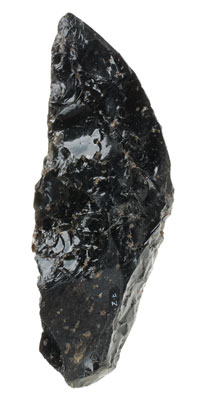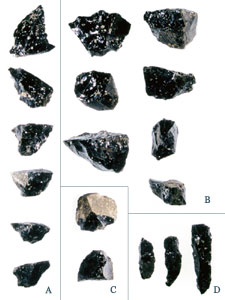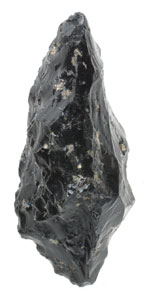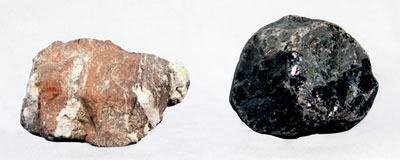Kengamine, Takaharayama Group:
An obsidian source site discovered atop a ridge. Were stone tools rough finished here, then transported to lowland areas?

Scattered distribution of obsidian
| 
Unfinished point
|
Kengamine Sector, Takaharayama Obsidian Source Site Group, Yaita City/Nasushiobara City, Tochigi Prefecture
Obsidian source site
The Takaharayama obsidian source site group consists of sites of the Upper Paleolithic (35,000-16,000 bp) in the vicinity of the summit of Takaharayama mountain in Tochigi prefecture.
Takaharayama lies approximately 20 km northwest of the urbanized sector of the city of Yaita, comprised of the peaks Maeguroyama, Myōjindake, Keichōsan, Shakadake, Nishihiradake, and Kengamine, encircling the caldera at its summit.
The sites of this group are located on the gentle slopes and level surface of the ridge extending from Kengamine (elev. 1,540 m), on the mountain’seastern edge, and continuing to Ōnyūdō (elev. 1,402 m). At roughly the midpoint between Kengamine and Ōnyūdō is a peak 1,440 m in elevation, centered on which a number of sites are thought to be spread over the area.
At one of these, discovered on top of the ridge, it was learned that stone tool production was conducted using obsidian of extremely good quality, containing few bubbles and impurities. Moreover, the site was fortunately covered with dark brown and light yellow-grey strata of volcanic ash, preserving it in a good condition for revealing the life of the time. Further, if the age of the volcanic ash deposit can be determined, it should give a more precise date for the time the site was utilized.
To where, and in what manner, did materials circulate from the source site?
The Yaita municipal Board of Education has been promoting studies of Takaharayama obsidian in the fields of geology and archaeology from fiscal 2002, which have met with considerable success. On the other hand, a vigorous survey of stone tool materials from the southern Tohoku to the northern Kanto regions, conducted by the Sekki sekizai kenkyūkai (Stone tool materials research group), led to the discovery of the group of sites in the Kengamine sector.
From the surface finds to date, along with the results of a test excavation conducted in October 2005, in addition to trapeze-shaped and knife-shaped tools, triangular cross-sectioned tools, projectile points, and cores, large quantities of flakes were discovered, but among these the presence of numerous large unfinished points draws attention. The raw materials were roughly worked and transported away from this locale, and probably made into finished products at the points of consumption. From these tools’ combinations and special characteristics, the sites are thought to correspond to the latter half of the Upper Paleolithic.
Based on the use of X-ray fluorescence spectrometry to identify obsidian sources, Takaharayama obsidian is known to be distributed at numerous locations centering on southern Kanto, being transported as far away as Shizuoka prefecture. In excavations scheduled to be conducted from fiscal 2006, it is anticipated that the range and nature of the site group will become clear, and that advances will be made in clarifying the actual conditions of society and trade of the times. (Ishikawa Hitoshi)
Explanation of the exhibits
Kengamine Sector, Takaharayama Obsidian Source Site Group (Yaita City/ Nasushiobara City, Tochigi Prefecture)

1. (A) Unfinished points, (B) unfinished knife-shaped tools, (C) triangular cross-sectioned tools, (D) side scrapers, (E) stone cores
Upper Paleolithic, ca 35,000-16,000 bp
Item at upper left: Length 4.6 cm, width 4.1 cm, thickness 1.9 cm
The scarcity of finished points and knife-shaped tools reflects the sites’ nature as an obsidian source. From their form, the knife-shaped tools are thought to be of the same period as the triangular cross-sectioned tools and points. Side scrapers were used in scraping tasks, and stone cores are the remaining portions of the source material, from which flakes were struck to serve as the raw material for stone tools.

2. (A) Points, (B) cores, (C) blades, (D) side scrapers
Upper Paleolithic, ca 35,000-16,000 bp
Item at upper left: Length 5.4 cm, width 5.1 cm, thickness 1.9 cm
Artifacts recovered from the test excavation, for which the inclusion of numerous large unfinished points draws attention. Including obsidian serving as raw material, some 4,387 stone flakes, etc. were recovered from the 0.5 meter square trench.

3. Triangular cross-sectioned tool Upper Paleolithic, ca 24,000 bp Length 8.0 cm, width 3.5 cm, thickness 3.2 cm A stone tool pointed at one end and triangular in cross-section, thought to have been used for thrusting and scraping. In the eastern part of the Kanto region there are many tools of this type made from Takaharayama obsidian, and triangular cross-sectioned tools were found at the current site as well. |

4. Unfinished point Upper Paleolithic, ca 17,000 bp Length 15.3 cm, width 5.8 cm, thickness 3.0 cm |

5. Raw obsidian Length 20.0 cm, width 19.5 cm, thickness 8.4 cm |
